![Educaplus: Fotosintesis [in Spanish]](https://openspace.infohio.org/static/newdesign/images/materials/default-thumbnail-index.png)
Observe the process of photosynthesis with this presentation.
- Subject:
- Science
- Material Type:
- Lesson Plan
- Provider:
- Educaplus (Jesús Peñas Cano)
- Date Added:
- 04/12/2021
![Educaplus: Fotosintesis [in Spanish]](https://openspace.infohio.org/static/newdesign/images/materials/default-thumbnail-index.png)
Observe the process of photosynthesis with this presentation.

This classroom activity introduces students to energy flow through organisms, producers & photosynthesis, and consumers & respiration.

This pathways explores how cells harvest energy using cellular respiration in eukaryotic cells and photosynthesis in plant cells.

Help your students understand one way to harvest energy from biomass -- by fermenting a plant-based sugar!

Students learn about energy flow in food webs, including the roles of the sun, producers, consumers and decomposers in the energy cycle. They model a food web and create diagrams of food webs using their own drawings and/or images from nature or wildlife magazines. Students investigate the links between the sun, plants and animals, building their understanding of the web of nutrient dependency and energy transfer.
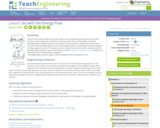
Students learn about energy and nutrient flow in various biosphere climates and environments. They learn about herbivores, carnivores, omnivores, food chains and food webs, seeing the interdependence between producers, consumers and decomposers. Students are introduced to the roles of the hydrologic (water), carbon, and nitrogen cycles in sustaining the worlds' ecosystems so living organisms survive. This lesson is part of a series of six lessons in which students use their growing understanding of various environments and the engineering design process, to design and create their own model biodome ecosystems.

In a multi-week experiment, student groups gather data from the photobioreactors that they build to investigate growth conditions that make algae thrive best. Using plastic soda bottles, pond water and fish tank aerators, they vary the amount of carbon dioxide (or nutrients or sunlight, as an extension) available to the microalgae. They compare growth in aerated vs. non-aerated conditions. They measure growth by comparing the color of their algae cultures in the bottles to a color indicator scale. Then they graph and analyze the collected data to see which had the fastest growth. Students learn how plants biorecycle carbon dioxide into organic carbon (part of the carbon cycle) and how engineers apply their understanding of this process to maximize biofuel production.

Each plant is classified according to broad categories based on characteristics they share. New DNA technology has allowed us to be more specific in determining the “relatives” of plants. This activity helps students understand the various ways of classifying to show these different relationships. Use HHMI Biointeractive Click and Learn lesson: Creating Phylogenetic Trees from DNA Sequences for additional background information. This unit features 5 lessons and 9 files. Lessons are aligned to NGSS.

Drones (or UAVs-unmanned aerial vehicles) are taking to the skies. What are they doing up there? What other technologies are there that help growers become more productive, yet more thoughtful about the effects on the environment, on which they depend on to continue producing food? This unit features 3 lessons and 5 files. Lessons are aligned to NGSS.

In this lesson students will plant and care for soybeans under one of three different photoperiod regimes: First month: 16 hours; Second month: 14 hours; third month: 12 hours (control). 16 hours for all three months (long days). * 12 hours for all three months (short days)
As the plants grow, students will analyze and maintain records of their plant’s progress. This unit features 2 lessons and 7 files. Lessons are aligned to NGSS.

From holiday string lights to the bright sun in the sky, light is everywhere around us - but what really is light? Get all your questions about light answered by Berkeley Lab scientists Baishakhi Bose, Mayank Sabharwal, and Yu Gao during December's After School Science Hour about the inner life of light. You'll also get to make your own sky simulator and learn the reasons behind the sky's changing colors
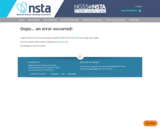
Students design and conduct simple experiments using elodea (aquatic plant sold in pet stores) and Bromthymol blue to determine whether plants consume or release carbon dioxide in the process of photosynthesis. Students will record their data which will be used to conclude whether carbon dioxide was consumed or released by the elodea. Through class discussion of student data, students will learn that carbon dioxide was consumed during photosynthesis.
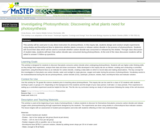
In this inquiry lab, students design and conduct simple experiments using elodea and Bromothymol blue to determine whether plants consume or release carbon dioxide in the process of photosynthesis. Students will record their data which will be used to conclude whether carbon dioxide was consumed or released by the elodea.

This site describes cellular components involved in light reaction and describes steps involved in photosynthesis.

This NetLogo model of leaf photosynthesis shows the macroscopic outcome of the reaction.
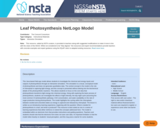
This Java-based NetLogo model allows students to investigate the chemical and energy inputs and outputs of photosynthesis through an interactive simulation. The simulation is a visual, conceptual model of photosynthesis and does not generate quantitative data. The central concept in the model is the role of chlorophyll in capturing light energy, and this concept is presented without delving into the biochemical details of the photosynthetic reactions. This allows students to focus on the core idea that photosynthesis transforms light energy into chemical energy. Along with exploring the basic process of photosynthesis, students can investigate the effects of light intensity, the day-night cycle (assuming the most common C3 photosynthetic pathway), CO2 concentration, and water availability on the rate of sugar production during photosynthesis. The model highlights the cycling within the chloroplasts between excited and unexcited states as energy is captured and released by chlorophyll. The lesson is written as an introductory learning experience, beginning with the question: What is needed for photosynthesis in a leaf, and what is produced? This resource is best suited as one in a series of learning experiences that either reinforce or extend the concepts addressed here. The model is embedded within an electronic form that provides instructions and guiding questions. Teachers and students should note that the electronic form does not save user data. An important limitation is that the model relies heavily on students visual perception, and this may pose a barrier for some students.
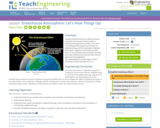
Students observe demonstrations, and build and evaluate simple models to understand the greenhouse effect, the role of increased greenhouse gas concentration in global warming, and the implications of global warming theory for engineers, themselves and the Earth. In an associated literacy activity, students learn how a bill becomes law and research global warming legislation.

This unit covers the processes of photosynthesis, extinction, biomimicry and bioremediation. In the first lesson on photosynthesis, students learn how engineers use the natural process of photosynthesis as an exemplary model of a complex yet efficient process for converting solar energy to chemical energy or distributing water throughout a system. In the next lesson on species extinction, students learn that it is happening at an alarming rate. Students discover that the destruction of habitat is the main reason many species are threatened and how engineers are trying to stop this habitat destruction. The third lesson introduces students to the idea of biomimicry or looking to nature for engineering ideas. And, in the fourth and final lesson, students learn about a specialty branch of engineering called bioremediation the use of living organisms to aid in the clean up of pollutant spills.

This video tutorial gives a detailed description of the various molecular actors in the light-dependent reactions. [6:37]
Khan Academy learning modules include a Community space where users can ask questions and seek help from community members. Educators should consult with their Technology administrators to determine the use of Khan Academy learning modules in their classroom. Please review materials from external sites before sharing with students.
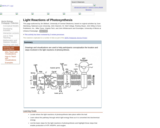
Drawings and visualizations are used to help participants conceptualize the location and steps involved in the light reactions of photosynthesis. The drawsing include light reactions of photosynthesis including location and steps for non-cyclic and cyclic photophosphorylation.